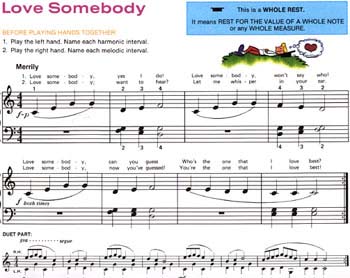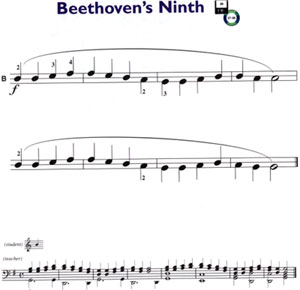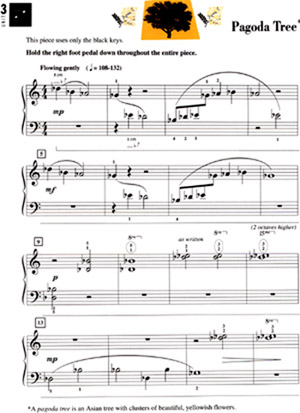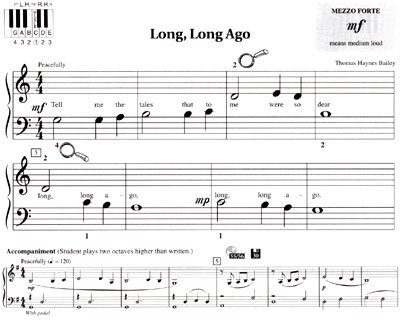
 |
|
Web Page by Huitzu Lin
|
|
|
|
|
|
|
|
|
|
The
Average-age Beginners
age 6 -8
The most developed market for piano method books is the group for children ages six to eight. This is because many piano teachers still believe that age six or seven is the ideal time for the child to begin piano lessons, unless particular talent or unusual interests warrant otherwise.
Alfred
Basic Piano Library
by Willard A. Palmer
 |
|
Alfred's
Basic Piano Library, Lesson Book, Level 1A
|
Levels:
Seven
levels: 1A, 1B, 2,3,4,5,and 6.
Materials:
Lesson books, Theory Books, Technic Books, Recital Books, Notespeller Workbook.
Supplements: Sheet Music Solo, Cassettes/CD, Flash cards, Fun Books, Hymn Books,
Merry Christmas Books Accompaniment Disk/CD.
Teacher's Guild.
Reading
Approach:
Multi-key
approach.
Strengths:
* Attractive
color pictures and graphics.
* The pacing is very well managed. There were at least one or two pages of instruction
per new concept, and review pages in the same level before moving on.
* Alfred used familiar tunes to stimulate student's interests.
* Very strong intervalic reading.
* New concepts are introduced very clearly and explained very detailed.
* Lessons are well planned.
Weaknesses:
*The
songs in this series are mainly homophonic. The arrangements are simple and
have a pleasant sound, but I wish that there is more variety of accompaniments.
*This method does not include any improvising, transposition or composing.
* The position approach limited student's acknowledge and opportunity to explore
their ears to the greater expansion.
* Too much folk tune. Original classical compositions should be presented earlier.
* No discussion
about the forms or history of the songs.
BACK
TO TOP
Bastien
Piano Basics
by James Bastien
Levels:
* Level
1, 2, 3, 4.
Materials:
* Method Books, Theory Books, Technic Books, Sight-reading Books(A Line A Day),
Solo Performance Books, Accompaniment Disks.
Reading
Approach:
Middle-C
reading approach before moving to the keys of G and F.
Strengths:
*
The songs and the notes are printed large, making them easy to read.
* A line A Day is a wonderful series of four levels to improve student's sight
reading skill.
Weaknesses:
* Pacing is too fast. There is only one or two songs to introduce the new
notes or new keys without any reinforcement.
* The arrangement is too bold. Most of the songs have only block chords for
the accompaniment.
* This method does not offer any improvising, transposition or composing.
* No discussion about the forms or history of the songs.
BACK
TO TOP
The
Music Tree
by Francis Clark & Louise Goss
 |
|
The
Music Tree, Time To Begin
|
Levels:
Time to Begin Part A, B, C, and levels 1 ~ 6.
Materials:
Music Tree Lesson Book, Keyboard Literature, Students' Choice (collection of
all-time recital favorites), Keyboard Technic, and Music Tree Activities (Theory).
Reading
Approach:
Intervallic.
Students are taught off the landmark note C and G.
Strengths:
* Excellent choice of songs with great variety of phrase lengths, range
and articulations.
* Teacher's accompaniments are musically interesting and conducive to interpretation
of moods, styles, tempo.
* The repertoire is admirably sequenced to provide ample reinforcement of all
concepts and skills.
* Students are experiencing in various keys right at the beginning.
* The method including improvising, transposition or composing and the discussion
of the forms.
* Emphasize on the technic from the beginning.
Weaknesses:
* This method moves very quickly in changing fingerings, note reading, positions
and keys, so it might suit a quick learner student better rather than average
students.
* The layout is not as attractive as in Alfred and Bastien.
BACK
TO TOP
Piano
Adventures
by Nancy and Randall Faber with Victoria Mcarthur
 |
|
Piano
Adventures, Performance Book, Level 2B
|
Levels:
Primer, level 1, 2A, 2B, 3A, 3B, 4, and 5.
Materials:
Lesson books, Theory,
Performance, Technique& Artistry, and Christmas books.
Reading
Approach:
Multi-position with frequently changing the traditional fingering of these
positions.
Strengths:
* Good selections of the repertoires, and beautifully arrangement of these
songs.
* It does not always stay on the five finger position, so that students learn
the basic technique such as phrasing, flexible wrist right on the very beginning.
The technique & artistry books are very well designed to reinforce those
techniques.
* Very detailed explanation and instruction while introducing a new concept
and terminology.
* Introduce the form, sequencing, transposition in the very early stage.
Weaknesses:
* Pacing is good for talented students or slightly older beginners such
as late 7 or 8 years old students. It would be too complicated to average young
six-year-old.
* Not a lot of repetition to reinforce the same style or concepts, thus students
would not learn it in great confidence.
* Although most of the songs are beautifully arranged, they are Faber's compositions
in homophonic style. Classical repertoires needed to be introduced earlier.
BACK
TO TOP
Hal
Leonard Student Piano Library
by Barbara Kreader, Fred Kern, Phillip Keveren, and Mona Rejino
 |
|
Hal
Leonard Lesson Book, Level 1
|
Levels:
Levels 1, 2, 3, 4 & 5.
Materials:
* Lesson, Theory, Technique, and Piano Solo Books(level 1-5).
* Piano Practice Games 1-4,
* Notespeller for Piano 1-2.
*Instrumental Accompaniments CDs, and MIDI Disks for Lesson, Technique, and
Solo Books..
Reading
Approach:
Middle-C approach.
Strengths:
* Very solid introduction of rhythmic readings. There are many pages of
reinforcement of the quarter note, whole note, and half note note before introducing
the new concept.
* Using a lot of familiar tunes.
* The accompaniment Disk is a big plus. They really did a fabulous job in arranging
these disks.
* Practice Games book included listening game to help identify different instruments
in the orchestra and to understand counter-melody
* All of the concepts are presented in an easy to understand manner.
* Pacing is slow and well balanced for young beginners. For those quick learners,
this method maybe too slow.
Weaknesses:
* This method did not include a variety selection of different repertoires.
* The middle-c approach limits students' acknowledge and opportunity
to explore their ears to the greater expansion.
* Concept of artistry was introduced too late. It should be included at the
very beginning so that student can have solid technic foundation.
BACK
TO TOP
 |
|
Robert
Pace, Book 1
|
Levels:
Levels 1-5
Materials:
Music for Piano; Creative; Theory Papers; Finger Builders.
Reading
Approach:
Multi-key approach.
Strengths:
* This method used different keys from the very beginning. This gives student
the opportunity to explore the different tonalities, and they will not be intimated
by the different position later on.
* The extensive using of the five finger pattern in all keys reinforce the Intervallic
reading.
* The concepts of sequencing, improvisation, transposition were introduced at
the very beginning. This enriches student's creativity.
Weaknesses:
* New concepts were introduced too fast. This would discourage the young
beginners. Because its complication, this method is better for the older beginners
or the students with some experiences.
* Teacher needs to read the teacher's guide thoroughly in order to teach.
* Page design is plain and unattractive for young students.
BACK
TO TOP
Return to >> Home
page || Preschool Beginners || Average-age
Beginners || Summary || Links
Any
Comments? E-mail your valuable comments to Huitzu
Lin